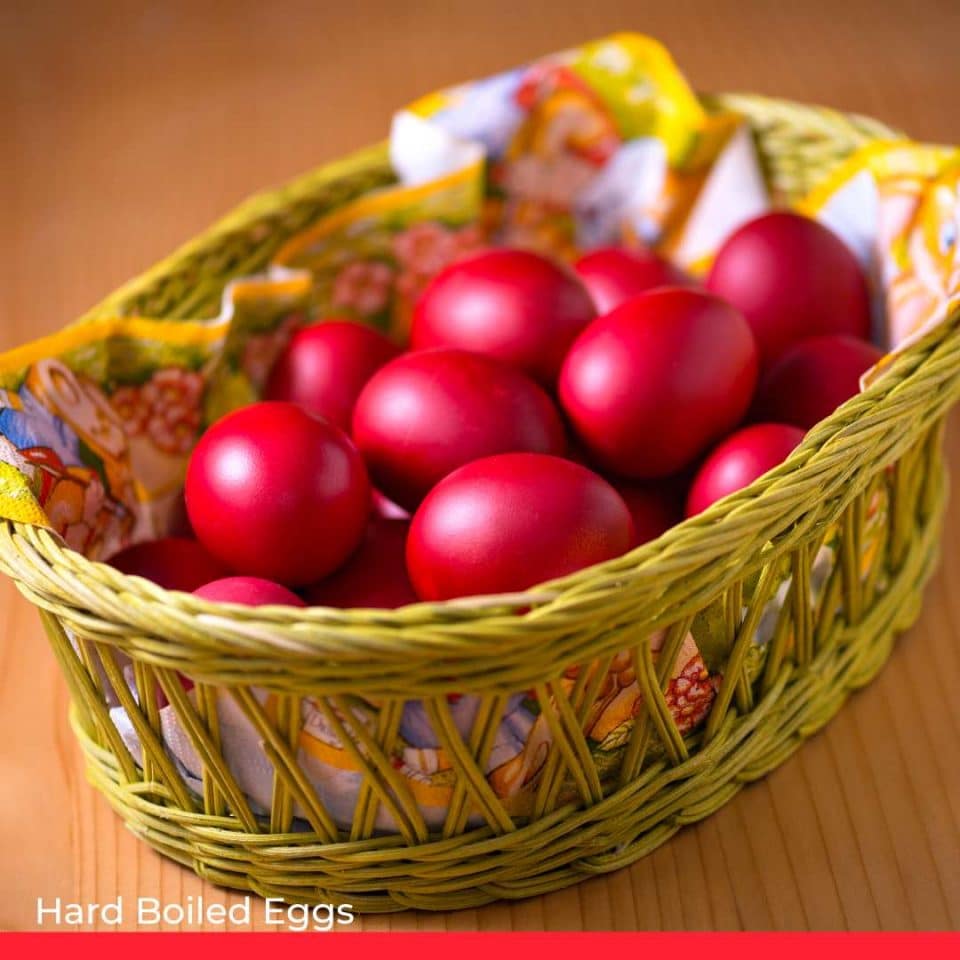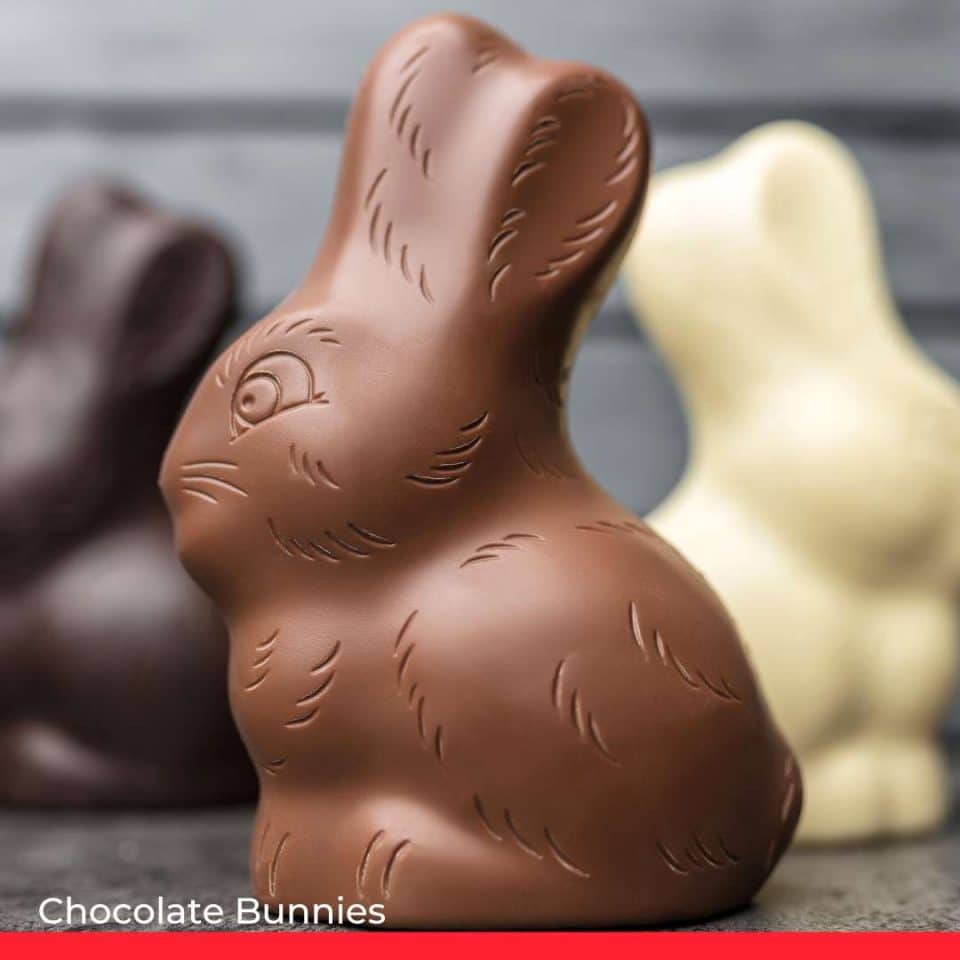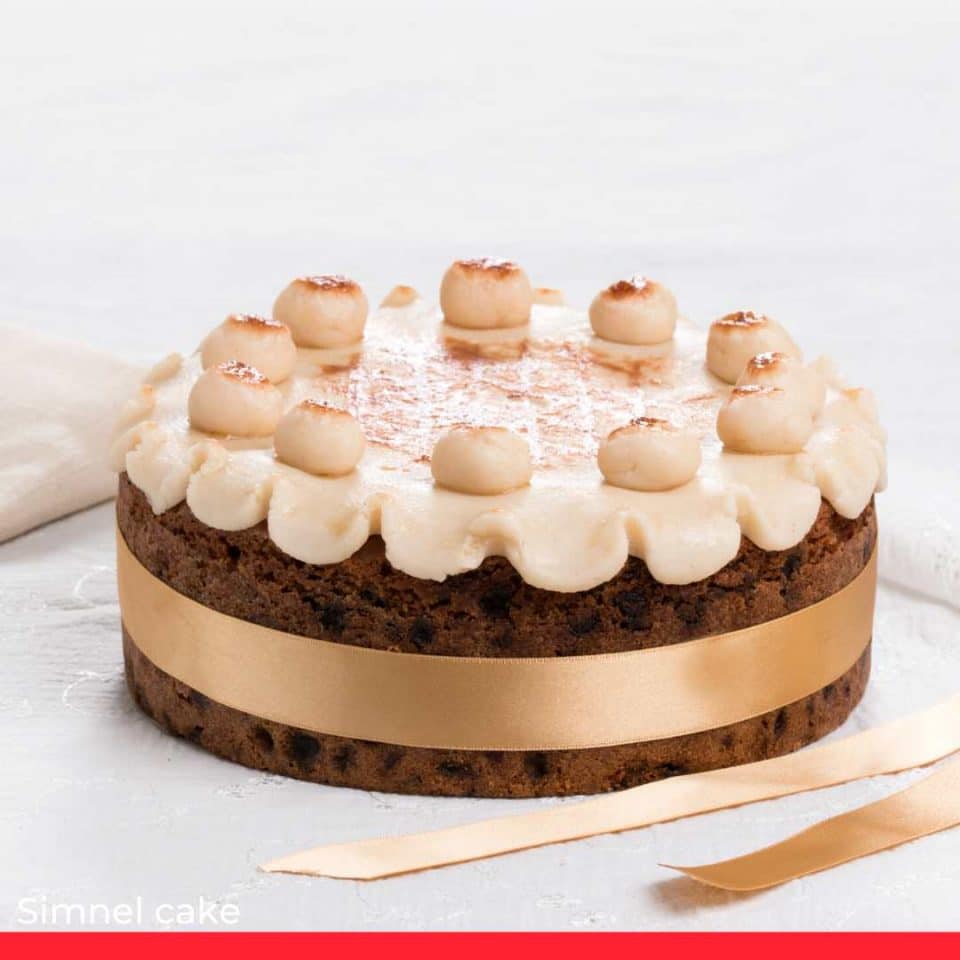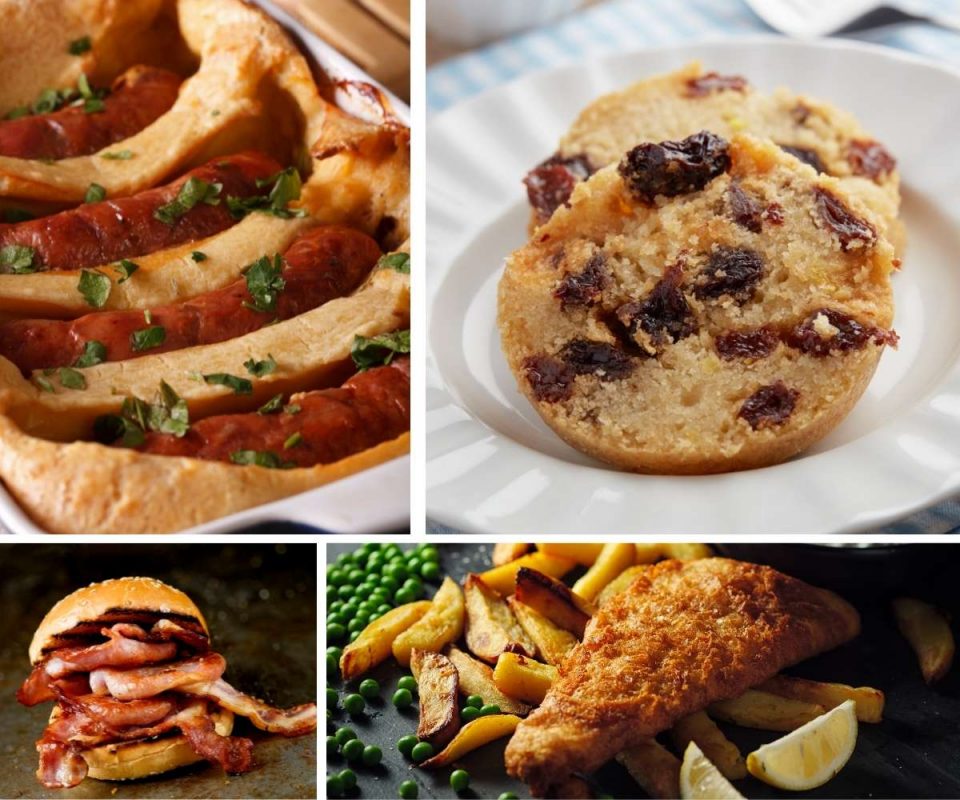As spring approaches, Easter is the time to shake off those winter blues! What better way to celebrate than with delicious food shared with family and friends? In the UK, you’ll find that ‘Easter foods’ range from centuries-old traditional recipes with a symbolic or religious origin, and new-fangled treats.
This article lists 12 popular savory and sweet British Easter foods. So whether you’re looking for inspiration to liven up your Easter Sunday dinner, revisit childhood memories, or delight the little ones in your life with some seasonal treats -read on to discover some ways you can make your Easter feast extra special!
1. Pancakes

While they’re not a regular part of the Easter Day celebration itself, pancakes are an unmistakable signal that Easter is on its way. Traditionally served on Shrove Tuesday (aka Pancake Day), they’re a last treat before Ash Wednesday and the forty days of fasting leading up to Easter itself.
They’re easy to make using store cupboard ingredients, and the whole family can enjoy the fun of flipping them over in the pan. Pro tip: to achieve the lightest pancakes, experts recommend ‘resting’ the batter for at least 30 minutes before cooking.
Fillings can be anything from a sprinkling of sugar and a squeeze of fresh lemon to luscious concoctions based on thick cream, rich yogurt, or chocolate spread -perhaps with some blueberries for a healthy finishing touch.
2. Hard Boiled Eggs

Early Christians painted chicken eggs red to symbolize Christ on the cross. Over time, cracking open hard or soft-boiled eggs on Easter Sunday came to represent the opening of Jesus’ tomb. Their connection with this time of year dates back even further.
In pagan times eggs were associated with new life, rebirth, fertility, and the brightness of spring.
Eggs were decorated in preparation for breaking the Lent fast – to make them even more special. It used to be easy to find eggs with shells dyed in rainbow colors, but this isn’t as common as it was in the past. However, painting empty eggshells is still a fun Easter ritual for kids and adults.
3. Roast Lamb

As the centerpiece of an Easter celebration meal, roast leg of lamb has traditionally been one of the most popular choices firstly because it was said to symbolize the purity and goodness of Christ. And also because spring is the best time of year to enjoy this succulent meat.
Roasting lamb is simple. A leg takes about 25 minutes per pound to cook to the point where the center is still slightly pink- it’s considered at its best when it’s medium/medium-rare. To prepare, pierce the skin and push garlic slivers into the slits so the juice will seep into the meat as it cooks.
Next, smother it with fresh or dried herbs – particularly rosemary, and place it into the roasting tin. Finally, add your pre-boiled potatoes to the roasting tin toward the end of cooking.
4. Cooked Ham

Another popular choice for special Easter meals is a ham, aka gammon, joint. This tradition doesn’t have any special symbolic meaning for Christians. However, as cured pork was the most readily available meat at this time of year, its popularity spread from Northern Europe to the UK, USA, and beyond.
Fresh young vegetables and boiled potatoes provide a fantastic complement to the natural sweetness of the ham. A balsamic glaze makes an ideal partner, as it enhances the flavor of the meat, but cooked ham can be paired with a wide variety of savory sauces.
5. Carrots-based Dishes

As Easter approaches, it’s a welcome sign that winter is over and warmer days are on their way. Perhaps that’s why Easter celebrations don’t focus on the heavy brassica vegetables, such as sprouts, that have seen us through the chilly months.
Instead, sweet and succulent young carrots are harvested as soon as the ground becomes soft enough to dig them up. They’re a familiar sight at Easter celebrations.
They’re not only a feature of savory dishes. Over recent years, carrot cakes decorated with creamy frosting have become a popular Easter treat. Pro tip: it’s impossible to overdo the decoration, so don’t hold back on the marzipan carrots, bunnies, and tiny chocolate eggs that have become a popular Easter treat.
Kids who take this kind of thing seriously leave carrots out at night for the Easter Bunny – perhaps hoping they’ve earned some gifts as a reward for being ‘nice’ since Christmas.
6. Chocolate Bunnies

Chocolate bunnies are everywhere at Easter. Over 90 million are produced and enjoyed each year! But what have rabbits got to do with Easter? As far back as pagan times, rabbits have symbolized fertility, rebirth, and the emergence of new life – all connected with the celebration of Easter each spring.
Rabbit isn’t a popular meat in the UK, though you may find it served in upmarket restaurants.
Better to enjoy in chocolate form, as the stores aren’t only flooded with versions from huge chocolate brands such as Cadbury and Lindt, but every artisanal chocolatier creates their unique twist on the theme.
For example, in 2015, British pastry chef and chocolatier Martin Chiffers created a life-sized chocolate rabbit with two solitaire diamonds (claimed to be worth $28k) for its eyes. Weighing in at over 10 lbs, this carved masterpiece stood 15 inches tall and contained an eye-watering 548,000 calories.
7. Chocolate Eggs

Chocolate eggs are easily the most popular Easter treat. They come in all sizes, hollow or filled with goodies. From brightly colored versions designed to delight kids to sophisticated adult offerings created from fine, single-estate cocoa beans – the choice is endless.
Cadbury’s Crème Eggs, with their ultra-sweet white and yellow filling, are so popular they’re sold year-round and almost worldwide.
At the other end of the market, upmarket London store Fortnum & Mason offer six real hen’s eggs, painted gold, with their contents removed and replaced with milk chocolate praline. They’re an intriguing symbol of Easter indulgence at $32 for a gold box of 6!
8. Hot Cross Buns

The tradition of making hot cross buns dates back at least to the 12th century. Queen Elizabeth the First decreed that they could only be eaten at Easter, Christmas, and funerals because they were believed to have magical healing powers!
Spicy, slightly sweet, and studded with dried fruit, they’re typically enjoyed alone with a cup of tea or halved, toasted, and buttered.
It is easy to make Hot Cross Buns at home, as long as you allow a couple of hours for the whole process, including resting the dough between kneading. To make the crosses, score the top of the bun or paste out of plain flour and water and create the lines.
If you have these buns left over after Easter, use them to make a Hot Cross Bun version of traditional Bread and Butter Pudding –and in the unlikely event that you have any chocolate Easter eggs left over, break these into pieces and scatter through the mixture.
Hot Cross Buns are also a popular Easter treat in the United States and Ireland.
9. Simnel Cake

In honor of the eleven disciples who went to heaven, Simnel cake is usually traditionally decorated with 11 marzipan balls of marzipan. (Judas Iscariot, who betrayed Jesus, is never included).
Simnel cake is a crossover treat as it originates in the Mothering Sunday tradition. This used to be celebrated on the fourth Sunday in Lent, so fasting rules were relaxed a little on this day, allowing people to enjoy the freshly baked cake.
Although simnel cake used to resemble Christmas cake, today’s versions are a lot lighter. This almondy fruitcake contains spices, dried fruit, zest, and candied peel. A layer of almond paste is baked into the middle. Sometimes orange flower water or even brandy is added to the cake batter or the filling.
It’s traditionally eaten at tea time on Easter Sunday.
10. Themed Easter Cakes

Even cupcakes or a simple Victoria sponge can become the centerpiece of an Easter tea time. Chicks, lambs, other baby animals, and springtime flowers are all popular decorative themes on Easter cakes.
As with many Easter traditions, these probably originate in pre-Christian pagan rituals around the coming of spring and the rebirth of nature.
As cupcakes and basic sponges are easy to make, using little more than butter, sugar, eggs, and flour, they’re ideal for getting kids involved in baking and using their imagination to create miniature works of art. Make it easy for them by using ready-rolled fondant icing, mini marshmallows, chocolate flakes, and rainbow sprinkles to add a touch of magic to any springtime scene.
11. Easter Biscuits

Easter biscuits are sometimes called “Cakes” and are eaten on Easter Sunday. Traditionally they’re a crunchy, sugary, shortbread-type biscuit studded with currants.
However, as they contain spices and sometimes lemon zest, they make a welcome and more ‘grown up’ change from the soft and sweet iced bunny and chick-themed cupcakes sold everywhere. They were traditionally homemade to friends and neighbors as an Easter gift.
12. Sparkling wine

Although the weather is likely to still be chilly, by Easter, the sun is coming out more often, and there are hints that summer is coming. Even in the cities – signs of new life are everywhere, and it’s finally time to come out of hibernation!
A glass of chilled English sparkling wine evokes the feeling perfectly. It makes an ideal aperitif before the special celebration meal. If you’re invited to share an Easter Sunday dinner, it’s a gift that every host will appreciate!
Related: 16 Traditional British Foods

Related: Popular British Desserts

The post Most Popular British Easter Foods appeared first on Chef's Pencil.
from Chef's Pencil https://ift.tt/FMQ19nR
via https://chefsspenncil.blogspot.com

No comments:
Post a Comment